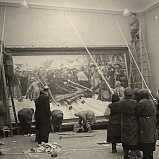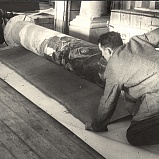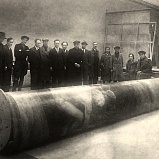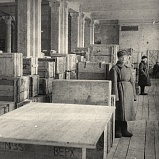There are a lot of interesting facts and events in the history of the Novosibirsk opera and ballet theatre. The theatre opened on may 12th 1945, which makes him a contemporary of the Great Victory. During the Great Patriotic War the theatre acted as a preserver of culture and a symbol of the Siberian persistent spirit.
The construction of this majestic building started in early 1930s. The theatre was getting ready to meet its first audience in August 1941; the main part was almost finished in 1940, some construction was still going on in the stage area. With the war breakout the biggest theatre facility in the country was destined to become a sort of an ark or a strong room for cultural assets of global value.
July 13th 1941 Council of People's Commissars of the USSR issued a decree allowing evacuation of unique pieces of art from the State Tretyakov Gallery, the Pushkin State Museum of Fine Arts, the State Museum of Modern Western Art, the State Museum of Oriental Art.
Soon after that, on July 21st 1941 the first train loaded with unique items set off from the Kazansky railway station to Novosibirsk. The same train carried the collection of rare musical items – priceless instruments crafted by Stradivari, Guarneri, Amati. This collection was kept in the Novosibirsk theatre building till November 6th 1944.
By the end of 1941 the Novosibirsk opera and ballet theatre contained a sheer number of artistic and cultural assets. The exhibit items came from the museums of Leningrad, Gorky, Smolensk, along with items from Ukrainian museums.
The items evacuated from the Russian Museum of Ethnography in Leningrad and those from museums in the town of Pushkin were first sent to Gorky town and then were forced to move deeper inside the country due to increased airstrikes, which finally brought them to Novosibirsk in the late 1942.
A bit earlier, in November 1942 a legendary cyclorama, or rather its remaining pieces were brought to Novosibirsk after being salved during the last days of the Heroic Defense of Sevastopol. It was created by Franz Roubaud in 1905 and dedicated to 50th anniversary of the heroic defense of the city against Anglo-French intervention during the Crimean war (1853-1856). It was in the Novosibirsk theatre, where the initial conservation efforts were applied to each fragment of the heavily damaged cyclorama: removing dust, stretching, primary cleansing, and fixation of paint layer.
The theatre building was not just a quiet vault – museum workers restored items, held exhibitions and gave lectures at various institutions of the town. Items of the State Tretyakov Gallery and the Russian Museum of Ethnography were displayed at different areas of the theatre.
Twenty two institutions in total operated and kept their assets at the Novosibirsk opera and ballet theatre.







